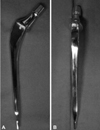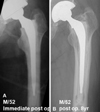Abstract
Purpose
Surface finishing of a cemented femoral stem is a subject of controversy even though the contemporary cementing techniques have improved results. Using the Versys Heritage femoral stem, we evaluated the outcome of using a polished surface.
Materials and Methods
The subjects of this study were 95 hip arthroplasties in 82 patients and we used a cemented polished femoral stem with the 3rd generation cement technique and all the surgeries were done between October 2000 and August 2003. There were 58 male patients (64 hips) and 24 female patients (31 hips). The mean age at the time of the index arthroplasty was 52.3 years (26~74 years), and the average body mass index was 24.2±2.75 (19.1~29.8). The average follow up period was 80.7 months (64~109 months). All the hips were evaluated clinically by the Harris hip score and the thigh pain, and they were radiologically assessed by the cement grade and the presence of osteolysis around the femoral stem, as well as the presence of stress shielding of the proximal femur.
Results
At the final follow up, the Harris hip score for all the patients had improved from preoperative 58.9 (17-83) to post operative 91.7 (72~100). The cement grade was measured using Barrack's method. Of the 95 hips, 45 (47.3%) cases were grade A, 48 (50.5%) cases were grade B and 2 (2.1%) cases were grade C1 at the final follow up. There was 1 case of definite loosening. Stress shielding was noted in 65 (68.4%) cases of the zero grade and 19 (20.0%) cases of the 1st grade.
Figures and Tables
 | Fig. 1Cemented Versys Heritage femoral stem preserves the stem geometry and polished smooth surface characteristics of Sir John Charnley's first stem. In addition, centralization devices can be used to achieve centralization at the top and bottom of the replacement hip joint. (A) Shows it AP profile and (B) shows lateral profile. |
References
1. Barrack RL, Mulroy RD Jr, Harris WH. Improved cementing techniques and femoral component loosening in young patients with hip arthroplasty. A 12-year radiographic review. J Bone Joint Surg Br. 1992. 74:385–389.

3. Harris WH. Is it advantageous to strengthen the cementmetal interface and use a collar for cemented femoral components of total hip replacements? Clin Orthop Relat Res. 1992. 285:67–72.

4. Harris WH, McCarthy JC Jr, O'Neill DA. Femoral component loosening using contemporary techniques of femoral cement fixation. J Bone Joint Surg Am. 1982. 64:1063–1067.

6. Engh CA, Bobyn JD, Glassman AH. Porous-coated hip replacement. The factors governing bone ingrowth, stress shielding, and clinical results. J Bone Joint Surg Br. 1987. 69:45–55.

7. Engh CA, Bobyn JD. The influence of stem size and extent of porous coating on femoral bone resorption after primary cementless hip arthroplasty. Clin Orthop Relat Res. 1988. 231:7–28.

9. Crowninshield RD, Jenning JD, Laurent ML, Maloney WJ. Cemented femoral component surface finish mechanics. Clin Orthop Relat Res. 1998. 355:90–102.

10. Callaghan JJ, Templeton JE, Liu SS, et al. Results of Charnley total hip arthroplasty at a minimum of thirty years. A concise follow-up of a previous report. J Bone Joint Surg Am. 2004. 86-A:690–695.
11. Charnley J. The long-term results of low-friction arthroplasty of the hip performed as a primary intervention 1972. Clin Orthop Relat Res. 1995. 319:4–15.
12. Halley DK, Glassman AH. Twenty- to twenty-six-year radiographic review in patients 50 years of age or younger with cemented Charnley low-friction arthroplasty. J Arthroplasty. 2003. 18:7 Suppl 1. 79–85.

13. Kavanagh BF, Wallrichs S, Dewitz M, et al. Charnley low-friction arthroplasty of the hip. Twenty-year results with cement. J Arthroplasty. 1994. 9:229–234.
14. Fowler JL, Gie GA, Lee AJ, Ling RS. Experience with the Exeter total hip replacement since 1970. Orthop Clin North Am. 1988. 19:477–489.
15. Issack PS, Botero HG, Hiebert RN, et al. Sixteen-year follow-up of the cemented spectron femoral stem for hip arthroplasty. J Arthroplasty. 2003. 18:925–930.

16. Lachiewicz PF, Messick P. Precoated femoral component in primary hybrid total hip arthroplasty: results at a mean 10-year follow-up. J Arthroplasty. 2003. 18:1–5.

17. Collis DK, Mohler CG. Loosening rates and bone lysis with rough finished and polished stems. Clin Orthop Relat Res. 1998. 355:113–122.

18. Collis DK, Mohler CG. Comparison of clinical outcomes in total hip arthroplasty using rough and polished cemented stems with essentially the same geometry. J Bone Joint Surg Am. 2002. 84-A:586–592.

19. Datir SP, Wynn-Jones CH. Staged bilateral total hip arthroplasty using rough and smooth surface femoral stems with similar design: 10-year survivorship of 48 cases. Acta Orthop. 2005. 76:809–814.

20. Crowninshield RD, Tolbert JR. Cement strain measurement surrounding loose and well-fixed femoral component stems. J Biomed Mater Res. 1983. 17:819–828.

21. Crowninshield RD, Brand RA, Johnston RC, Milroy JC. The effect of femoral stem cross-sectional geometry on cement stresses in total hip reconstruction. Clin Orthop Relat Res. 1980. 146:71–77.

22. Kaneuji A, Yamada K, Hirosaki K, Takano M, Matsumoto T. Stem subsidence of polished and rough double-taper stems: in vitro mechanical effects on the cement-bone interface. Acta Orthop. 2009. 80:270–276.
23. Crawford RW, Evans M, Ling RS, Murray DW. Fluid flow around model femoral components of differing surface finishes: in vitro investigations. Acta Orthop Scand. 1999. 70:589–595.

24. Scheerlinck T, Casteleyn PP. The design features of cemented femoral hip implants. J Bone Joint Surg Br. 2006. 88:1409–1418.

25. Firestone DE, Callaghan JJ, Liu SS, et al. Total hip arthroplasty with a cemented, polished, collared femoral stem and a cementless acetabular component. A follow-up study at a minimum of ten years. J Bone Joint Surg Am. 2007. 89:126–132.

26. Jewett BA, Collis DK. Radiographic failure patterns of polished cemented stems. Clin Orthop Relat Res. 2006. 453:132–136.

27. Della Valle AG, Zoppi A, Peterson MG, Salrati EA. A rough surface finish adversely affects the survivorship of a cemented femoral stem. Clin Orthop Relat Res. 2005. 436:158–163.

28. Smith SW, Estok DM 2nd, Harris WH. Total hip arthroplasty with use of second-generation cementing techniques. An eighteen-year-average follow-up study. J Bone Joint Surg Am. 1998. 80:1632–1640.

29. Woolson ST, Milbauer JP, Bobyn JD, Yeu S, Maloney WJ. Fatigue fracture of a forged cobalt-chromium-molybdenum femoral component inserted with cement. A report of ten cases. J Bone Joint Surg Am. 1997. 79:1842–1848.

30. Kawate K, Ohmura T, Hiyoshi N, Natsume Y, Teranishi T, Tamai S. Thin cement mantle and osteolysis with a precoated stem. Clin Orthop Relat Res. 1999. 365:124–129.

31. Ito H, Matsuno T, Minami A. Pre-coated femoral components in hybrid total hip arthroplasty. Results at 11 years. J Bone Joint Surg Br. 2005. 87:306–309.
32. Ong A, Wong KL, Lai M, Garino SP, Steinberg ME. Early failure of precoated femoral components in primary total hip arthroplasty. J Bone Joint Surg Am. 2002. 84-A:786–792.

33. Madey SM, Callaghan JJ, Olejniczak JP, Goetz DD, Johnston RC. Charnley total hip arthroplasty with use of improved techniques of cementing. The results after a minimum of fifteen years of follow-up. J Bone Joint Surg Am. 1997. 79:53–64.

34. Mann KA, Gupta S, Race A, Miller MA, Cleary RJ, Ayers DC. Cement microcracks in thin-mantle regions after in vitro fatigue loading. J Arthroplasty. 2004. 19:605–612.

35. Ramos A, Simões JA. The influence of cement mantle thickness and stem geometry on fatigue damage in two different cemented hip femoral prostheses. J Biomech. 2009. 42:2602–2601.

36. Shon WY, Hur CY, Moon JG, Rho YJ, Jung SH. Six to ten year follow-up study of primary hybrid total hip arthroplasty using a precoate stem. J Korean Hip Soc. 2003. 15:78–86.
37. Yates PJ, Burston BJ, Whitley E, Bannister GC. Collarless polished tapered stem: clinical and radiological results at a minimum of ten years' follow-up. J Bone Joint Surg Br. 2008. 90:16–22.




 PDF
PDF ePub
ePub Citation
Citation Print
Print




 XML Download
XML Download